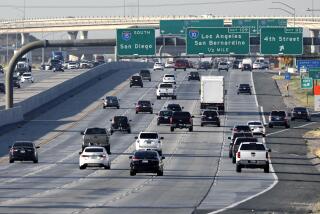Carpool Lanes Built, but Will They Be Used?
Only Southern California would mark the opening of congestion-clearing carpool lanes with a traffic-stopping parade of classic cars.
That is precisely what transportation officials did Thursday to celebrate the long-awaited closure of a six-mile gap in the San Diego Freeway carpool lanes between the Harbor and Long Beach freeways, creating the longest stretch of continuous carpool lanes in Southern California--59.5 miles, from Los Angeles International Airport to San Juan Capistrano.
Until Thursday, the longest continuous carpool lane was a 50-mile stretch that opened last year, going from California 57 in Diamond Bar to Interstate 5 in Orange County to San Juan Capistrano.
Now--this being Southern California--one question remains: Will drivers use the lanes?
Only about 14.5% of Southern Californians commute by carpool--a percentage that has remained virtually unchanged over the years despite a multibillion-dollar program to add carpool lanes to freeways. Even with offers of $2 a day in gift certificates for every day of car-pooling and guaranteed taxi rides home in emergencies, it’s hard to break solo commuters of their drive-alone habit.
Orange County has the most miles of carpool lanes of any county in the state. But the lack of ridership has transportation officials questioning whether more diamond lanes are the answer to reducing traffic congestion.
The Orange County Transportation Authority is now reconsidering its long-established plans to add diamond lanes to the Garden Grove Freeway, a $122-million project.
A survey released earlier this year found that a third of Orange County ridesharers prefer using regular lanes to carpool lanes, which some consider less convenient and unsafe.
Caltrans officials consider the carpool lanes a success, noting that Southern California at least has held its own while car-pooling nationwide has declined. They say the benefits will become more apparent as gaps in the high-occupancy vehicle lane system are completed.
“As we bring these pieces together, people are going to be more likely to rideshare,” Tony Harris, Caltrans’ director for Los Angeles and Ventura counties, said at Thursday’s ceremony in Carson.
The carpool lanes that were opened Thursday--six miles in each direction--cost $28 million, took three years to build and were funded by the Metropolitan Transportation Authority, largely from Los Angeles County’s penny-on-the-dollar transit sales tax. The lanes are expected to save car-poolers an average of 6 minutes on their trip during rush hour. The lanes also help solo commuters, officials say, because they draw cars out of the regular traffic lanes.
Car-poolers were delighted.
“It was great,” Richard Davidson, a civil engineer from Huntington Beach who vanpools with six co-workers to their jobs at Los Angeles International Airport, said about his morning drive in the new lane.
Traffic has been so bad on the southbound San Diego Freeway during the evening commute that he and his colleagues often take a roundabout way home--traveling Interstate 105 to the 110 to the 91 to the 605 to the 405. “Tonight, we’re going to go the straight route,” he said.
John Dunwoody, a senior scientist from Long Beach who carpools to Hughes Space and Communications in El Segundo, said his morning commute has been reduced from 50 minutes to 35 as segments of carpool lanes have opened up. “I’m very happy that it’s open,” he said.
Absent from the celebration was Assemblyman Tom McClintock (R-Northridge), a critic of carpool lanes who suggested, “One crew with a sandblaster could open up enormous additional capacity on these freeway lanes simply by removing the hated diamond.” He plans to reintroduce state legislation to study whether carpool lanes actually work.
Caltrans engineers say that if they opened carpool lanes to general traffic, they would fill up rapidly and reach the same gridlock conditions as other traffic lanes.
Dawn Helou, a Caltrans senior engineer who oversees high-occupancy vehicle operations in Los Angeles and Ventura counties, said the raw number of car-poolers is increasing. “Look at how many driver’s licenses we’re passing out every day,” she said. “To maintain a 14% car-pooling rate out of the number of driver’s licenses we hand out every day is a real success story.”
Orange County is adding carpool lanes on the Santa Ana Freeway through Anaheim and Buena Park, and on portions of the Corona del Mar Freeway in Costa Mesa and Newport Beach.
The Garden Grove Freeway project is considered the last leg of the county’s program. Officials have put off a final decision, though, awaiting completion of a study on whether carpool lanes actually work.
Some places are considering dismantling their underused carpool lanes. But C. Kenneth Orski, president of Urban Mobility Corp., a transportation consulting firm in Washington, D.C., said, “Generally speaking, the HOV lanes in Southern California have been among the more heavily utilized lanes in the nation.”
Indeed, some carpool lanes are reaching capacity during rush hour, and traffic engineers have talked about raising carpool lane requirements from two to three occupants per car.
But if the rules change, they fear something they call “empty lane syndrome,” with too few car-poolers. They also fear that evicting two-person carpools would worsen traffic congestion in other lanes. Even worse, they fear a public backlash--the kind from the disastrous Santa Monica Freeway diamond lane experiment of the 1970s, when they faced a public revolt after taking away a traffic lane and converting it to a carpool lane. Since then, the policy has been never to take away anything; they add lanes for carpools.
(BEGIN TEXT OF INFOBOX / INFOGRAPHIC)
Carpool Connection
Carpool lanes on the San Diego Freeway between the Harbor and Long Beach freeways opened Thursday, creating the longest continuous stretch of high-occupancy vehicle lanes in Southern California--59.5 miles from Los Angeles International Airport to San Juan Capistrano.
More to Read
Sign up for Essential California
The most important California stories and recommendations in your inbox every morning.
You may occasionally receive promotional content from the Los Angeles Times.











